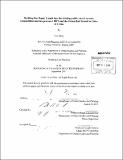| dc.contributor.advisor | Ralph Gakenheimer. | en_US |
| dc.contributor.author | Zhan, Yun, M.C.P. Massachusetts Institute of Technology | en_US |
| dc.contributor.other | Massachusetts Institute of Technology. Dept. of Urban Studies and Planning. | en_US |
| dc.coverage.spatial | a-cc--- | en_US |
| dc.date.accessioned | 2012-02-29T17:56:56Z | |
| dc.date.available | 2012-02-29T17:56:56Z | |
| dc.date.copyright | 2011 | en_US |
| dc.date.issued | 2011 | en_US |
| dc.identifier.uri | http://hdl.handle.net/1721.1/69459 | |
| dc.description | Thesis (M.C.P.)--Massachusetts Institute of Technology, Dept. of Urban Studies and Planning, 2011. | en_US |
| dc.description | Cataloged from PDF version of thesis. | en_US |
| dc.description | Includes bibliographical references. | en_US |
| dc.description.abstract | BRT is a new type of bus transit with high speed and capacity. With its advantages and benefits, BRT is getting popular in the world, including China. Since BRT and urban rail transit (URT) are both rapid public transports, the comparisons between the two will be inevitable. Generally speaking, BRT could theoretically reach the speed and capacity of light rail, but there is still a gap in abilities between BRT and metro. Though for construction investment, BRT is much lower-cost than the same-length metro, if considering the land value and exclusive effects altogether, the total cost of a BRT system could increase faster with the raise in passenger numbers. Therefore, depending on different development stages, cities should choose the right mode with highest efficiency as the dominant public transit. Sometimes, both of the systems should work in corporation for the best effectiveness. Though there are competition and substitution between BRT and URT, compatibility and complementarity also exist. The integration between the two will bring us a new understanding on the developments of the urban transit system. For integration of BRT and URT, thoughtful network planning is the first step. Second, the service quality and efficiency of transfers between the systems should be emphasized. Also important, a cooperative management will be necessary. At the same time, land development opportunities should be considered with this integration trend. | en_US |
| dc.description.statementofresponsibility | by Yun Zhan. | en_US |
| dc.format.extent | 140 p. | en_US |
| dc.language.iso | eng | en_US |
| dc.publisher | Massachusetts Institute of Technology | en_US |
| dc.rights | M.I.T. theses are protected by
copyright. They may be viewed from this source for any purpose, but
reproduction or distribution in any format is prohibited without written
permission. See provided URL for inquiries about permission. | en_US |
| dc.rights.uri | http://dspace.mit.edu/handle/1721.1/7582 | en_US |
| dc.subject | Urban Studies and Planning. | en_US |
| dc.title | Building bus rapid transit into the existing public transit system : competition and integration of BRT and the Urban Rail Transit in cities in China | en_US |
| dc.type | Thesis | en_US |
| dc.description.degree | M.C.P. | en_US |
| dc.contributor.department | Massachusetts Institute of Technology. Department of Urban Studies and Planning | |
| dc.identifier.oclc | 774917366 | en_US |
